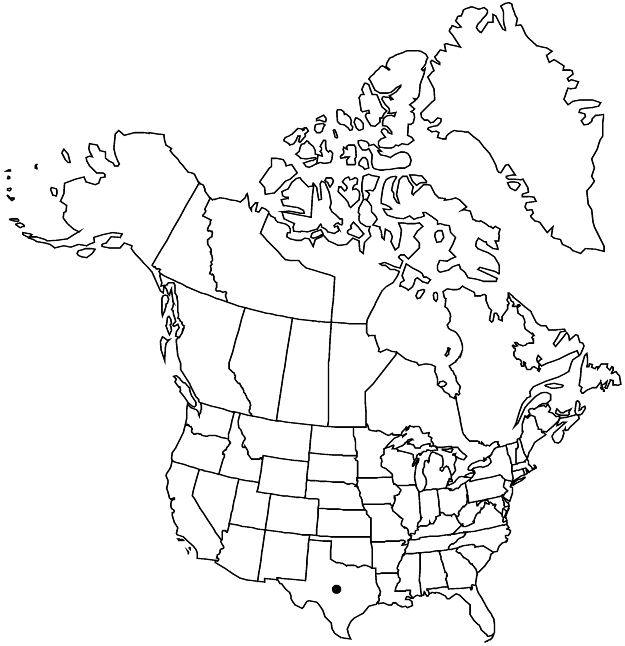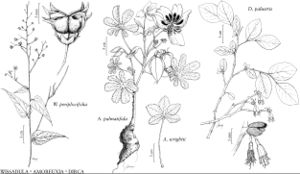Difference between revisions of "Amoreuxia wrightii"
Smithsonian Contr. Knowl. 5(6): 26. 1853.
FNA>Volume Importer |
imported>Volume Importer |
||
| (6 intermediate revisions by 2 users not shown) | |||
| Line 10: | Line 10: | ||
|special_status={{Treatment/ID/Special_status | |special_status={{Treatment/ID/Special_status | ||
|code=F | |code=F | ||
| − | |label= | + | |label=Illustrated |
}} | }} | ||
|basionyms= | |basionyms= | ||
| Line 28: | Line 28: | ||
|elevation=0–400 m | |elevation=0–400 m | ||
|distribution=Tex.;Mexico;West Indies (Curaçao);South America (Peru). | |distribution=Tex.;Mexico;West Indies (Curaçao);South America (Peru). | ||
| − | |discussion=<p>Amoreuxia wrightii is morphologically homogeneous throughout its disjunct range (H. H. Poppendieck 1981).</p> | + | |discussion=<p><i>Amoreuxia wrightii</i> is morphologically homogeneous throughout its disjunct range (H. H. Poppendieck 1981).</p> |
|tables= | |tables= | ||
|references= | |references= | ||
| Line 37: | Line 37: | ||
-->{{#Taxon: | -->{{#Taxon: | ||
name=Amoreuxia wrightii | name=Amoreuxia wrightii | ||
| − | |||
|authority=A. Gray | |authority=A. Gray | ||
|rank=species | |rank=species | ||
| Line 51: | Line 50: | ||
|publication title=Smithsonian Contr. Knowl. | |publication title=Smithsonian Contr. Knowl. | ||
|publication year=1853 | |publication year=1853 | ||
| − | |special status= | + | |special status=Illustrated |
| − | |source xml=https:// | + | |source xml=https://bitbucket.org/aafc-mbb/fna-data-curation/src/2e0870ddd59836b60bcf96646a41e87ea5a5943a/coarse_grained_fna_xml/V6/V6_700.xml |
|genus=Amoreuxia | |genus=Amoreuxia | ||
|species=Amoreuxia wrightii | |species=Amoreuxia wrightii | ||
Latest revision as of 23:23, 5 November 2020
Stems 15–50 cm, glabrous or sparsely lanulose-puberulent (mostly on young growth), glandular. Leaves: petiole 3–8 cm, subglabrous to sparsely lanulose-puberulent (mostly on young growth), glandular; blade 5(7)-lobed, 3–5 × 4–7 cm, lobes subrhombic, distal half of margins serrate, apex rounded to acute, tooth of central lobe apex most distal. Peduncles 2.5–5 cm. Flowers 3–7.5 cm diam.; sepals narrowly oblong-ovate, 17–20 × 5–8 mm, apex acute; petals pinkish to orange, distal petals with 2 conspicuous purplish marks at bases, lateral petals each with 1 purplish mark at base; distal set of filaments 5–10 mm with yellow anthers, proximal set of filaments 11–17 mm with usually dark red anthers; ovary usually short-haired-lanate to tomentose or puberulent (glandular). Capsules oblong-obovoid, 3–6 cm, sparsely pubescent (glandular). Seeds globose to ovoid, glabrous. 2n = 12.
Phenology: Flowering May–Jul(–Oct).
Habitat: Dry, rocky or gravelly hills, plains, deserts, grasslands, shrublands, along roads or railroads, limestone soil, silty flats
Elevation: 0–400 m
Distribution

Tex., Mexico, West Indies (Curaçao), South America (Peru).
Discussion
Amoreuxia wrightii is morphologically homogeneous throughout its disjunct range (H. H. Poppendieck 1981).
Selected References
None.
